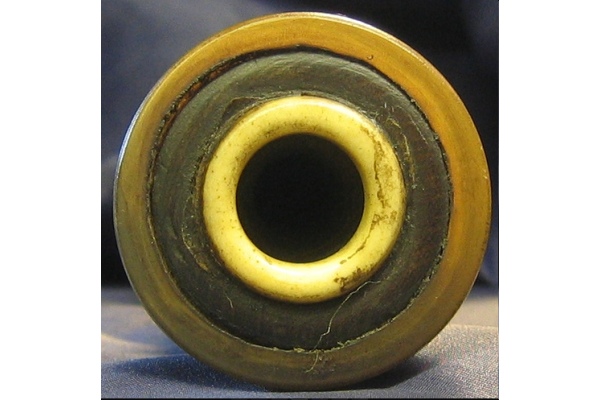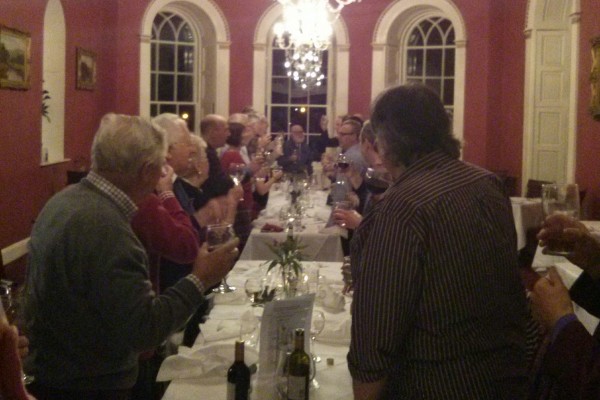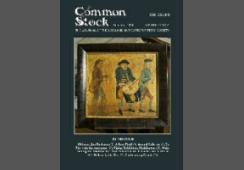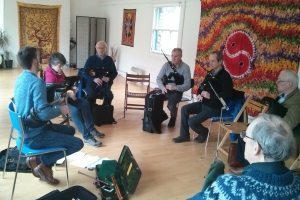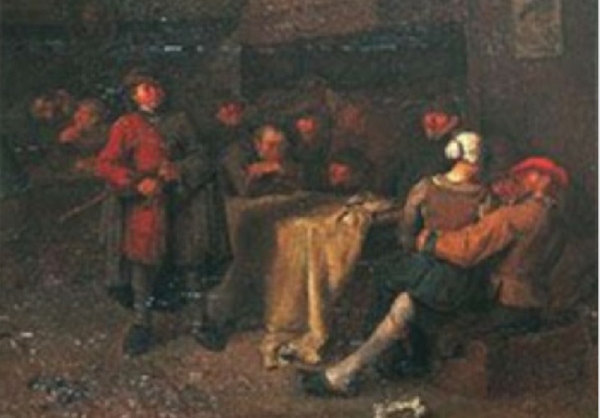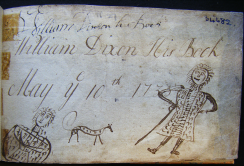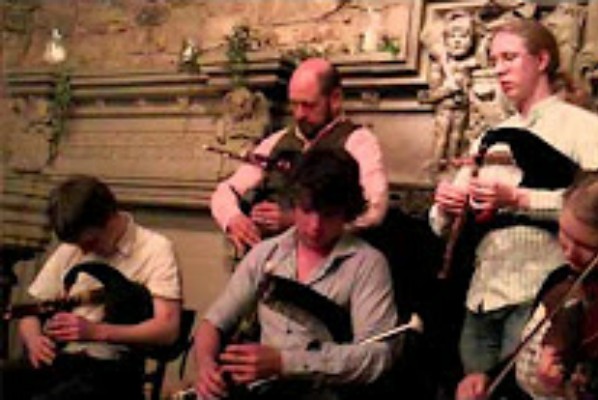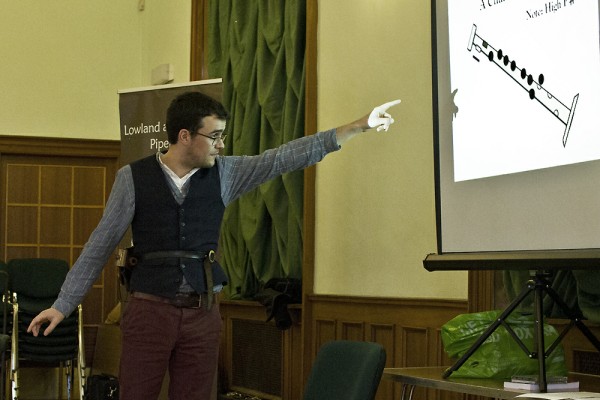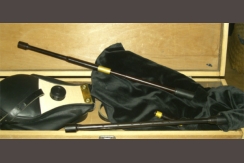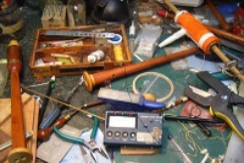This is an edited version of Pete Stewart’s presentation at this year’s Collogue.

*The image, titled ‘A Rocking’, is from The Book of Scottish Song by Alex Whitelaw, 1855; thanks to Keith Sanger for providing this. A ‘rocking’ is a gathering for the purpose of communal spinning and winding of yarn -rocking and reeling, one might say.
You may perhaps have read, in the last issue of Common Stock, an article by John Dally titled ‘The Lowland Reel’ in which he offered some thoughts on the performance of ‘Lowland reels’. In his article, having discussed an approach to exploring the rhythm of the music he adds: “Once you decide upon a certain rhythm you must develop it, make it danceable, and rub some dirt into it’. During one of the evening sessions we used to have in our kitchen, Martin Lowe asked what I thought John had meant by this last remark. It was that question which led to this talk.
I had for some time been considering the notion of dance in the Lowlands. It seems to me that prior to the middle of the 18th century there had existed a popular culture in the Scottish Lowlands that was independent of that in the Highlands, coloured perhaps more by Northern European culture than by North West Scotland. This culture went underground as the century wore on and enchantment with the Highlands took over. There was, I was sure, something of value still to be recovered of this tradition. It was while doing some background reading on the question that I encountered the following revealing remark:
“There are only three things which are important when you are playing for dancing – time, sound and dird”1
These are the words of an Orkney fiddler named Danny Rosie in 1920. The word ‘dird’ was completely new to me. Rosie is said to have been playing for a dance along with a lad who had attempted some complicated ornamentation to the tune; the remark was made when the lad stumbled in his playing. When I asked John Dally whether he had intended a reference to the word in his remark about ‘rubbing in some dirt’ he confessed that he had indeed been aware of the word, having been introduced to it by none other than Gordon Mooney some years ago in Vermont.
The authors attempt to explain the word as follows: “the accent given to the notes, that extra something that makes the on- lookers’ feet tap and gives the life and lift to the dancers”. I well remember this word ‘lift’ from my early days of playing in the 1970’s; even then it seemed undefinable - all that could really be said was that you would recognize it when you heard it. To understand ‘dird’ we need to understand both dance and music; unfortunately, we know very little about dance in Scotland, particularly in the Lowlands outside Edinburgh, in the period when Lowland music was at its peak, before it was subsumed by ‘Highland’ music and the ‘country dance’. We do however, have some remarkable survivals from which we can create a picture, if a hazy one.
The first is an excerpt from the ‘Orchesographie’, a French dance manual published in 1589 by ‘Thoinot Arbeau’ [a pseudonym]. The collection contains instructions for dancing pavanes, galliards and a whole list of bransles. The bransle seems to have been a generic term for the various ‘peasant dances’ familiar in most of Northern Europe in the 16th century. The ‘Scottish Bransle’ was popular, Arbeau says, “20 years ago”, c.1570 [see fig. 2]. As in many of these dances, Arbeau describes the steps as either ‘double’ or ‘simple.’ In addition to the steps printed alongside the music, Arbeau generously included diagrams. I have put together the diagrams which make up a ‘double á droit’ - a double step to the right [fig. 3] This ‘double’ consists of a step to the right, an approach of the left foot to the right and another step to the right. The final element of the step is what Arbeau calls a ‘Pied Croisé’, in this case, it is the left foot that is ‘crossed’. This particular step is unique to the ‘Scottish Branse’; this is the only place it appears in all of Arbeau’s manual.2 It seems that this step is what makes this dance ‘Scottish’; it may be the origin of the ‘pas de bas’ setting step so familiar to Scottish dancers.3

Fig 2: Bransle d’Ecosse

Whatever the relation of this dance to Scottish dancing in the 16th century, the Fletts argued that of the four dance types familiar [in 1964] in Scot- land, only the reel was trully indigenous. They defined the reel as consisting of two sections, one the ‘travelling’ figure, the other the ‘stepping’; they were careful to avoid limiting the ‘travelling’ to what we today would see as definitive – the ‘figure of eight’; although there are two dances in Arbeau’s collection which feature an interweaving figure [the B. de la Hey’ and the B. de Montarde] it does not appear in his B. d’Ecosse. Today the ‘Reel’ is more or less universal in Scot- land. Tracing its origins is not easy, however. The famous list of dances contained in the 1550 publi- cation The Complaynt of Scotland does not mention the reel. The first reliable use of the word that I know of to describe dancing appears in the Burgh records of Kirkcaldy in 1584 [only a few years before Arbeau’s publication]: “Tha na persounis pas tyme, nor dans or reill with dansing and pypping throw the toun” There is no description of the dance itself here, but the implication of ‘dancing through the town’ is perhaps that this was some kind of line dance. A slightly more informative usage appears a few years later in the famous East Lothian witch trials: “they took hands and daunced this reill or short dance, singing all with one voice … Geillis Duncane did goe before them playing this reill or daunce uppon … a Jewes trump”4 There seems little doubt that this was a ‘ring dance’ or at least a ‘line’ dance, since there were said to be over 200 witches present, and we are told that they ‘took hands’. As for the reel as we know it, the threesome or foursome, the first ref- erence I have seen appears a little later, in a poem by Alexander Craig of Rosecraig; •“Twixt Fortune, Loue, and most vn- happie mee, Behold a chase, a fatall threesome reele”5 Though Craig was born in Banffshire in the North-East Lowlands, he wrote most of his poetry in London whilst at the court of James VI/I. This reference to a threesome reel stands out amongst the obscure classical references in the rest of his poetry; it does seem to indi- cate that his readers would by that time be familiar enough with his reference. Throughout the 17th century referenc- es to dancing abound – usually in Kirk Sessions as part of reprimands and pro- hibitions, which clearly had little effect. The general impression is that these were outdoor dances, though occasion- ally ‘having pipers in their house’ is part of the offence. I figured that one conse- quence of the distaste in the reformed church for dancing may have been the withdrawal of the dance indoors, with the resulting contraction of the number of dancers; was this the origin of the threesome? I was not surprised to find that the Flett’s had reached this conclu- sion long before me - although they also seem to contradict themselves by the suggestion that the presence of ‘uneven sexes’ suggests a court origin, possibly a 16th century import from France. I am unaware of any further references to the reel throughout the 17th century, but by the early years of the 18th century it is clear that the dance was familiar enough in Edinburgh. In the glossary to Ruddiman’s edition of Douglas’ Aeneiad published in 1710 we are told of two types of dance, the reel ‘as a threesome rell .. When three dance together’ and the ‘Ring Dance’, ‘a kind of dance of many together in a ring or circle taking one another by the hands and quitting them again at certain turns of the tune’ .. and sometimes the piper is put in the center [sic].” [see pp. 28/29] In fact, the ‘ring dance’ seems to have survived in remote areas into the 20th century. The Fletts mention the exis- tence in the Western Highlands and Islands [from Skye in 1895] of a ‘circular reel’ which consisted mostly of a ring of dancers, man and woman alternately [as partners] dancing one behind the other in a circle, and then stepping to their partner; and in 1914 Mabel Dolmetsch described a similar dance in Sutherland known there as the ‘Braile’. Were these dances, as the Fletts suggested, the remnants of the 16th century, the original bransles d’Ecosse?
Before going on to discuss the music for the ‘reel’ in its earliest forms, I cannot avoid including the following note which Robert Riddell added to the tune ‘Simon Brodie’, in his Collection of Scotch Galwegian and Border Tunes’ in 1794. I confess that I do not currently know what to make of this. We should be able to take Riddell as being as reliable as any authority of the period on this subject, and yet what he says here appears to contradict what we have learnt so far; clearly, the threesome reel had been familiar in Edinburgh for at least eighty years when his book was published.

However we treat this remark, the question remains, what kind of music were dancers responding to in the 17th century, and what can we learn about playing the lowland repertoire? It so happens that an answer of sorts does survive from around the time of the earliest references to the reel which we have discussed. The English musi- cian Andrew Holmes preserved an ex- tended composition in a manuscript dated around 1595, entitled ‘The Scots Huntsup’.6 It is an amalgamation of three or four tune types which were to form the basis of Scottish music throughout the next century. One of these ‘archetypes’ appears in numerous later sources. In Scotland its various versions have their own titles; in English sources it is known simply as ‘The Scottish Jigge’.
The first of these sources is a crudely written setting of the tune in tablature added in 1629 [I’m told] to a copy of Robinson’s 1609 tutor for the cittern,7 Fortunately, we have a much more carefully notated version. The Peter Ley- cester Bass Viol manuscript, now in Chester, was compiled some time around 1640 and contains a number of ‘Scottish’ tunes. This one [fig. 4] is one of those set for the viol tuned ‘Bagpipe Way’. [see Common Stock June 2011]. You can hear a Scottish version of the theme from around 1615 played by Ron MacFarlane on his CD ‘The Highland King’; this version is titled ‘Within ane Inch I Warrant’ and comes from the Rowallan lute manuscript. Ron plays this at around 56 bars/min, a tempo which is determined largely by the runs of quavers.

Fig 4 ‘The Scottish Jigge’ from the Leycester Bass Viol manuscript, c.1640
The basic material of the theme was worked and re-worked into many differ- ent tunes which grow in elaborateness through the 17th century. One of these variants may be familiar to lowland pip- ers as the Wappenschaw tune ‘Put on Your Sark on Monday’, versions of which appear in many collections of 17th century Scottish music. You can hear Rob McKillop play one from the Millar/Mcalman cittern manuscript, c.1650, on his CD ‘Flowers of the For- est’. His interpretation of this elusive tablature is vivid but possibly just too fast [around 72 bars/min].
The theme went on being re-worked throughout the 18th and well into the 19th century. When it appeared in Aird’s Collection in the 1780’s it had gained the title ‘The Fykett’ and this is the title it has in The Piper’s Assistant’ John McLachlan’s collection of bagpipe mu- sic published in 1854. In fact, McLachlan printed two versions; one he labelled ‘Reel’ and the other ‘March’ [figs. 6 & 7]

Fig 6 ‘The Fykett - Reel’ from The Piper’s Assistant, 1854

Fig 7 ‘The Fykett - March’ from The Piper’s Assistant, 1854
What kind of speed would today’s dance musician play the reel version? A quick survey of Youtube dance bands reveals a preponderance of reels played around 56-60 bars/min. But the march probably wants the old tempo which I suggest would be around 28-30 bars/m. I say 56 bars/min for the reel, but notice what has happened here; the orig- inal 4 bars have been halved in note value, and a second group of 4 bars have been added. Thus the theme is now being played at twice the speed. The process of ‘halving’ the note values in a notation seems to have begun during the early years of the 18th century. We see it in the change from settings using the ‘3’ sign, to which today we would allot a time signature of 9/4 or 6/4, to ones notated as 9/8 or 6/8. At the same time, these new settings tend to be rather more elaborated, often under the influ- ence of Italian and French baroque de- velopments. We can see this process well demon- strated in ‘Simon Brodie’, the tune that Robert Riddell assigned to his ‘Cumber- land/ Jig/ Strathspey dance.

Fig 8 ‘Old Simon Brodie’ from the Bowie fiddle manuscript, c.1705

Fig 9 ‘Simon Brodie’ from David Young’s manuscript ‘A Collection of the Newest
Country Dances Danced in Scotland’, 1740
The first version [fig. 8] comes from the George Bowie fiddle manuscript; pretty much the same version is in the Balcarres Lute Book; you can hear Ron McFarlane playing the Balcarres setting on the CD ‘Highland King’. His perfor- mance – at around 44 bars/min -is perhaps rather slower than suggested by the words of the silly song which David Herd published in 1769; “Honest, auld Symon Brodie, Stupid, auld, doited bod- ie; I'll awa' to the North Countrie, And see my ain dear Symon Brodie.”; around 56-60 bars/min seems more appropriate When the tune appears in David Young’s 1740 ‘Collection of the Newest Country Dances Danced in Scotland’ [fig. 9] we have a rather different ver- sion; here, as in the McLachlan ‘Fykett’, the note-values have been halved, and 2 bars contracted into one, but, allowing for the unusual addition of two bars [bars 2 & 3] the theme remains as 4 bars, not extended to 8. But the crucial feature is those semi-quavers in bar ‘4’; it would be difficult as well as uncomfortable to play this bar at ‘reel’ speed [60 bars/min?]; in fact, a much more appro- priate approach is play the quavers here at something nearer to the speed we have seen optimal for the ‘jigge’ theme, that is around 28-30 bars/min, though some might prefer a little faster. I suggest that this tempo should be generally applied to Lowland ‘Reels’ of this period, particularly when they are made up of 4 bar strains rather than 8. This question of tempo, not surprising- ly, is crucial when we come to consider the ‘dird’ of these tunes, the way in which they might be played that would encourage the dancers in their stepping. However, before we look more closely at this matter, I want to introduce the first music that appears with the title ‘reel’ [first, that is, with the exception of Playford’s ‘Cummers of Largo – A Reill’ which is in 9/4]. It appears in George Skene’s fiddle book of 1717.

Fig 10 ‘A New Reill’ from George Skene’s fiddle book, 1717
Again, at first sight, it looks like the kind of reel we could play at today’s reel speed, around 56-60 bars/min. But when we look at some of Skene’s other similar tunes, we see that he includes passages that could not effectively be played at that speed. Again, something like 28-30 bars/min makes more sense.

Fig 11 ‘Cauld Kail in Aberdeen’ [strains 7 & 8] from George Skene’s fiddle book, 1717
Most highland pipers, when they first consider how a simple-time tune should be played, look first at the time-signa- ture. A ‘C’ {‘usually called ‘common time’, somewhat misleadingly] indicates the counting of 4 beats in a bar [usually crotchets]; a vertical line through the C [‘Cut-time’] indicates 2 beats in a bar [usually minims]. So what can we learn from the use of time signatures in this early music? Well, Skene gives us no help here, since he omits the time signature altogether. The Leycester manu- script setting of the ‘Scottish Jigge’ has the ‘C’ sign. Balcarres, however, when writing the Simon Brodie tune, gives a Cut Time sign, as does David Young. Riddell also uses the ‘Cut Time’ sign, despite his use of semi-quavers, which imply a slower tempo and suggest a count of 4. Indeed, in strain 2, as if to confirm the ‘dird’ here, he has added slurs [bowing marks] to the opening of the 2nd strain.

Fig 12 ‘Simon Brodie’ from A Collection of Scotch Galwegian and Border Tunes,
Robert Riddell, 1794
When we turn to McLachlan’s reels, we discover that of the 39 he prints, 15 have a ‘Cut Time’ signature, and 24 have the ‘C’ signature, without there being any discernable difference. One of the ‘reels’ McLachlan gives a ‘Common Time’ sign to is his ‘Glen Lyon’; it is a version of the tune that appears in Young’s Collection as ‘Eccles Rant’ with Young’s usual ‘Cut Time’ sign. My conclusion would be that for this music, time signatures, or for that matter the manner in which notes are beamed into groups, can tell us little about the ‘dird’ that would have been given the tunes by a competent dance musician of the day.

Fig 13 ‘Mrs Christie’ - Strathspey from The Piper’s Assistant, 1854

Fig 14 ‘Stormont Lads’ - Strathspey from The Piper’s Assistant, 1854
McLachlan uses the ‘C’ sign for another variety of simple-time tune, which he labels ‘strathspey’ - here are two. In ‘Mrs Christie’ [fig. 13] there is not much sign of what we have come to expect from a strathspey; it looks just like [and sounds quite like] our ‘Scottish Jigge’. Now, though when McLachlan uses dotted rhythms they seem carefully placed, today’s interpretation of the strathspey is often at odds with its notation; but this is not my point; I merely wish to point to the similarity in notation between McLachlan’s ‘strathspeys’ and David Young’s cut-time tunes, which we might interpret and perform as reels, but which I want to suggest should be played very much slower. When we do so, a very different ‘dird’ emerges. For instance, here is another tune from David Young’s collection, one which may be familiar to Lowland pipers, having been printed in a number of collections. [Fig 15]

Fig 15 ‘The Wood of Fyvie’ - from David Young’s A Collection of the Newest Country
Dances Danced in Scotland, 1740
Again we have what looks like a standard ‘reel’ and the version printed the LBPS ‘Blue Book’ could be treated as such. However, those semi-quaver pas- sages in the 2nd strain in Young’s ver- sion won’t play happily at the reel speed of 56-60 bars/min.8 Precise decisions will differ, but the principle remains that these old ‘reels’ seem to have been played far slower than today’s reels; 30 bars per min is what seems right to me - strathspey speed, in fact.
And what about the Dird? Well, we can’t be sure of course about the kind of stepping involved in the reel in the 17th century, but there seems little reason to assume that it has changed much in essence. The basic principles can be described, principles which seem to go back at least as far as Arbeau’s ‘simples’ and ‘doubles’, which we might notate as ‘1&2& ‘and 123&’, the ‘&’ representing a pause, or perhaps a hop or kick, in the step, and hence determining a point of ‘lift’. The affect of reducing the tempo as I have suggested is that each step now occupies half a bar rather then the whole bar, so that each group of 4 quavers counts 1-2-3–& [as indicated by Young’s use of trills over his 3rd note in each group] and comes much closer to a polka rhythm, not, perhaps, something that today figures strongly in the highland piper’s repertoire. It is a very different effect to the ‘1-& 2-&’ of the more standard way of playing reels. [fig. 16]

Fig. 16 ‘Old Reel and ‘New Reel’ dird compared.
I’m not suggesting that this is a principal to be rigidly applied - hopefully, each tune will reveal its own internal dird, but it does begin to create the space to ex- plore ways in which the these rhythmic patterns might be introduced. As to the question of how these rhythms might be expressed by the piper’s technique, that is a very different question. There is, however, little substitute for beginning with the direct personal experience of the dance itself.

Fig. 17 ‘Let’s shak her Weall’, 1726; courtesy of Jack Campin ‘Old Scottish Flute Mu-
sic’ http://www.campin.me.uk/Flute/Webrelease/Flute/Flute.htm
[Ed: the following is from Gordon Mooney (via John Dally) on the subject of ‘dird’}
I have heard it used in the sense of the drive or forward motion in a tune or as modern musicians would say “the groove”. I remember Bob Hobkirk (who was a Scottish fiddle champion from the Borders) talk about playing for dancing and saying that he would simplify a tune (over that version he would play in a competition) and concentrate on the dird of the music – the beat and rhythm being more important than ornament or even accurate playing. With piping I think it is quite a skill and challenge to be able to do this and not stumble and lose the dird –breaking away from the idea of making “mistakes” and opening up the idea of improvising or adding variations is probably a new concept to
most pipers reared on the pipe band ethic.
Notes
1 Flett, J.F. & T.M., Traditional Dancing in Scotland, London, 1964; The History of the Scottish Reel as a Dance-Form: I.& II in Scottish Studies: Journal of the School of Scottish Studies, Univ. of Edinburgh 16:2 (1972): 91-119 & 17:2 (1973): 91-107
2 In fact this is not strictly true; it also appears in the ‘Gavotte’, but Arbeau implies that dancers should choose their own steps for that dance.
3 Several Youtube videos of a re-enactments of the dance are available; one can be seen on the lbps website version of this talk.
4 Ritson, J., Newes From Scotland, 1794
5 ‘To Kala’, Craig, A., Poetical Works, 1606
6 The full piece is printed in my The Day it Daws.
7 The original is in a copy of Thomas Robin- son’s Lessons for the Cittern [1609] viewable online at http://nanki-ml.dmc.keio.ac.jp/M- 06_072_R044/content/0021_large.html
8 A forerunner of ‘The Wood of Fyvie’ titled ‘Let's shak her Weall’ is on Jack Campin’s wonderful flute music site [Fig. 17]; it is from Dan Wright's book Aria di Camera of 1726, and contains even more extended sequences of semi- quaver runs, of the kind expanded in Young’s Macfarlane manuscript setting; [see Matt Seattle’s Over the Hills and Far Away]
